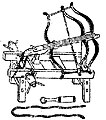catapult
Catapult ( ancient Greek καταπέλτης katapeltēs , from κατά- kata- "against, against" and πάλλειν pallein "fling"), also known as a throwing machine , describes a large, non-portable long-range weapon which uses mechanical energy to accelerate projectiles from a resting state.
history
Antiquity
In defense technology , the term “catapult” is used to describe throwing machines that have been built since ancient times and that were initially only used to shoot stones and arrows. What exactly was understood by the various forms such as “ ballista ” or “euthytonon” is partly controversial in science.
The origin is in Syracuse at the time of Dionysius I in the 4th century BC. . Chr suspected. These were mainly used as siege weapons . Armies usually carried no or only a few catapults with them because the transport was very complex and new ones could be built everywhere due to the wide availability of wood. The drive medium for these catapults, also known as onagers , were mostly materials under tension ( wood , rope or sinews ), which had to be tensioned beforehand by the work of the operating personnel.
middle Ages
In addition to stones and arrows, catapults could also throw incendiary projectiles such as falarika . In the late Middle Ages , very large catapults called bliden were built. Occasionally people , mostly prisoners , were catapulted over city or fortress walls . On the one hand, this was a method of execution , but it was mostly intended to demoralize the opponent behind the walls . Last but not least, the use of plague corpses or human or animal corpses otherwise contaminated with pathogens as projectiles was an early form of biological warfare , for example during the siege of Kaffa by the Tartars in the 14th century.
A common catapult since the 11th century was the Zugblide ( French pierrière ). It was smaller and lighter than the Blide without a counterweight. The limb was operated with muscle power via ropes. It mainly fired stone balls up to about 80 m with a rate of fire up to 2 / minute and served primarily for defense, but was also used in attack. It was often served by women. A famous victim was Simon IV de Montfort at the siege of Toulouse in 1218.
Modern times
The general technical progress also made catapults with steel springs possible. Various designs are known, but they are not particularly widespread. With the beginning of the modern era , catapults were largely replaced by propellant-powered guns , which allowed a greater range and greater accuracy.
In the First World War , catapults were still used militarily to hurl hand grenades into enemy trenches over the " no man's land ". Improvised catapults were also used in World War II to be able to throw hand grenades or incendiary devices in street fights.
Designs
The names of the different types of catapults are not uniform. They vary greatly depending on the era and the language that was predominant at the time.
Basically two principles, the spring force and the tensile force , were used. The aim was to give the bullet the highest possible kinetic energy on its way and to hit the target as precisely as possible. In catapults with a lever arm, there was also a sling rope at the end of the lever arm, which acted like a sling . As an alternative, there were also catapults with a shell or basket for the projectile at the end of the lever arm.
Spring force
The spring force was the appropriate principle for light and medium catapults. The force was generated by a leaf spring or a torsion spring ( torsion gun ). In order to store more energy, some of these were also used at the same time.
- One-armed torsion catapult (horizontal), called onager and mangonel
- Double arm Torsionskatapult (vertical), called Balliste or scorpion Euthytonon (Speerschleuder) Palintona and Cheiroballistra or Manuballista
- Single-armed leaf spring (horizontal)
- Two-armed leaf spring (vertical), called a bow catapult
- Several two-armed leaf springs in a row
- Mixed forms between torsion and leaf springs
traction
Medium and large catapults used the pulling force of a counterweight created by gravity . In the case of smaller models, the pulling force of people was also used. On the Blide or Trebuchet, there was also a sling rope at the end of the lever arm.
See also
literature
- Hans Aufheimer: Ship armament from the beginning to the middle of the 19th century . VEB Hinstorff Verlag, Rostock 1983.
- Friedrich Engels: Catapult . in Karl Marx / Friedrich Engels: Works , page 265. Dietz Verlag, Berlin. Volume 14, 4th edition 1972. Unchanged reprint of the 1st edition 1961, Berlin / GDR. Online version in The New American Cyclopædia , Volume IV.
- W. Gohlke: The guns of antiquity and the Middle Ages , in Volume 6 (1912-1914) of the magazine for historical weapons, publisher: Association for historical weapons, Dresden, 1915, pages 12 to 22. (online digitized)
- Robert Grosse , Roman military history from Gallienus to the beginning of the Byzantine thematic constitution, 1920, ISBN 978-0-405-07083-9 , limited preview in Google book search
- Hans Michael Schellenberg: Diodor of Sicily 14,42,1 and the invention of the artillery in the Mediterranean area . Frankfurter Electronic Rundschau zur Altertumskunde 3 (2006), pages 14-23. Frankfurt December 21, 2006. Online version in the Frankfurt University Library (PDF; 209 kB)
- Günter Ulbert: Der Auerberg , CH Beck Verlag, Munich 1994 ISBN 978-3-406-37500-2 , limited preview in the Google book search












